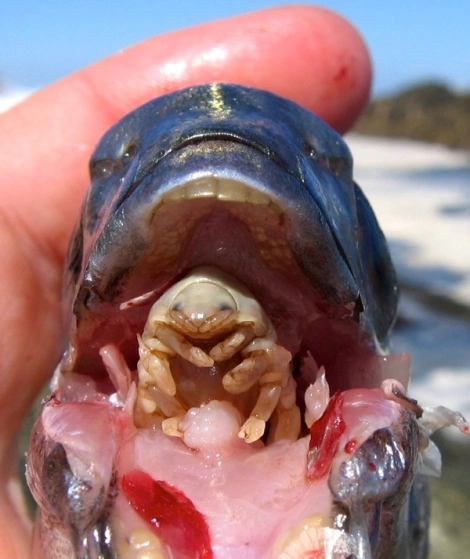WE’VE MOVED! COME JOIN US HHERE
The tongue-eating louse is the only example of a parasite that lives by crawling into another animal and after dispatching with a body part lives as a rather awkward replacement. It does so with relatively little harm to the poor bloody fish, though it is said the poor bloody fish rarely gets a smooch these days.

say aaaaah
He’s an unwanted guest, like some insufferable bugger from college who comes around and stays far too bloody long, at least he would be if said guest came in ate your chaise longue and quickly proceeded to decimate your wine cellar and didn’t leave until the day they died. The tongue-eating louse is quite possibly the most repugnant thing on the planet, worse than the Major’s wife and even a sniper wouldn’t take her out.

just a quick kiss... no no don't mind him
This louse is quite simply a monster, albeit a little one. The crustacean crawls into the gills of a fish, scrambles up to the mouth and stabs its claws either side of the fishes tongue. Despite its name it doesn’t actually eat the tongue, the organ atrophies as the parasite slurps the blood taking with it all the oxygen and nutrients and what not. There the louse sits for the rest of its life, why the blazes they never evolved to eat the tasty morsels the poor bloody fish is eating is anyone’s guess. One also wonders how they find this living-in-a-fishy mouth lifestyle satisfying.

... well on tuesdays i do Spanish classes... and on Thursdays I do salsa
So do we at The Proceedings wish we’d never mentioned the horrible buggers? Quite the opposite we think they are really rather grand! An incredible example of a pinnacle of evolution…. you see parasites rather obviously live off another animal to the hosts detriment. It’s a rather lazy, but devilishly clever survival technique that has arisen again and again independently throughout the course of evolution. It’s safe to say almost every single animal of any size has at least one. The really really clever, or more to the point the really well-evolved parasites, tap the hosts resources all the while leaving the host to live quite normally and hence as long as possible…. so that the parasite can tap more and more resources, and make more and more horrible little offspring. And we at The Proceedings can think of no other parasite that does it quite so well.
Indeed the closest we could think of is our own offspring, living off the nutrients of the blood of its mother, before popping out being a bit of a pain until you can eventually pack them off to a cripplingly expensive boarding school at the age of four. Which is at least some good news for the parents as they get back to smooching, a smooch that contains millions of micro-organisms, some of which are parasites.






